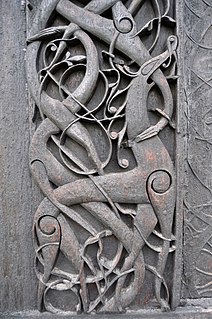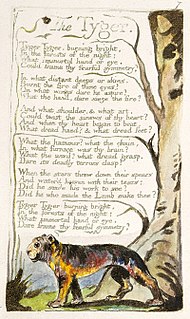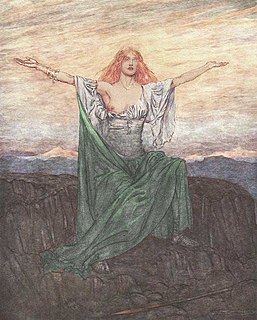An ode is a type of lyrical stanza. It is an elaborately structured poem praising or glorifying an event or individual, describing nature intellectually as well as emotionally. A classic ode is structured in three major parts: the strophe, the antistrophe, and the epode. Different forms such as the homostrophic ode and the irregular ode also enter.
A quatrain is a type of stanza, or a complete poem, consisting of four lines.

In Norse mythology, Ragnarök is a series of events, including a great battle, foretelling the death of a number of great figures, natural disasters and the submersion of the world in water. After these events, the world will resurface anew and fertile, the surviving and returning gods will meet and the world will be repopulated by two human survivors. Ragnarök is an important event in Norse mythology and has been the subject of scholarly discourse and theory in the history of Germanic studies.
In poetry, a stanza is a group of lines within a poem, usually set off from others by a blank line or indentation. Stanzas can have regular rhyme and metrical schemes, though stanzas are not strictly required to have either. There are many unique forms of stanzas. Some stanzaic forms are simple, such as four-line quatrains. Other forms are more complex, such as the Spenserian stanza. Fixed verse poems, such as sestinas, can be defined by the number and form of their stanzas. The term stanza is similar to strophe, though strophe sometimes refers to an irregular set of lines, as opposed to regular, rhymed stanzas.

In Norse mythology, Valhalla is a majestic, enormous hall located in Asgard, ruled over by the god Odin. Half of those who die in combat travel to Valhalla upon death, led by valkyries to be with Odin, while the other half gets chosen by the goddess Freyja for the field Fólkvangr. In Valhalla, the dead warriors join the masses of those killed in combat and various legendary Germanic heroes and kings, as they prepare to aid Odin during the events of Ragnarök. Before the hall stands the golden tree Glasir, and the hall's ceiling is thatched with golden shields. Various creatures live around Valhalla, such as the stag Eikþyrnir and the goat Heiðrún, described as standing atop Valhalla and consuming the foliage of the tree Læraðr.

Yggdrasil, in Norse cosmology, is an immense and central sacred tree. Around it exists all else, including the Nine Worlds.
A rhyme scheme is the pattern of rhymes at the end of each line of a poem or song. It is usually referred to by using letters to indicate which lines rhyme; lines designated with the same letter all rhyme with each other.
"Do not go gentle into that good night" is a poem in the form of a villanelle by Welsh poet Dylan Thomas (1914–1953); it has been described as his most famous work. Though first published in the journal Botteghe Oscure in 1951, the poem was written in 1947 while Thomas visited Florence with his family. Subsequent publication, along with other Thomas works, include In Country Sleep, And Other Poems and Collected Poems, 1934–1952.

Childe Harold's Pilgrimage is a long narrative poem in four parts written by Lord Byron. The poem was published between 1812 and 1818. Dedicated to "Ianthe", it describes the travels and reflections of a world-weary young man, who is disillusioned with a life of pleasure and revelry and looks for distraction in foreign lands. In a wider sense, it is an expression of the melancholy and disillusionment felt by a generation weary of the wars of the post-Revolutionary and Napoleonic eras. The title comes from the term childe, a medieval title for a young man who was a candidate for knighthood.

"The Tyger" is a poem by the English poet William Blake, published in 1794 as part of his Songs of Experience collection and rising to prominence in the romantic period. The poem is one of the most anthologised in the English literary canon, and has been the subject of both literary criticism and many adaptations, including various musical versions. The poem explores and questions Christian religious paradigms prevalent in late 18th century and early 19th century England, discussing God's intention and motivation for creating both the tiger and The Lamb.
The Prophecy of Berchán is a relatively long historical poem written in the Middle Irish language. The text is preserved in the Royal Irish Academy as MS 679 (23/G/4), with a few early modern copies. It is a prophecy made in the Early Middle Ages.

Sigrdrífumál is the conventional title given to a section of the Poetic Edda text in Codex Regius.

Easter, 1916 is a poem by W. B. Yeats describing the poet's torn emotions regarding the events of the Easter Rising staged in Ireland against British rule on Easter Monday, April 24, 1916. The uprising was unsuccessful, and most of the Irish republican leaders involved were executed for treason. The poem was written between May and September 1916, printed privately, 25 copies, and appeared in magazines in 1920 but first published in 1921 in the collection Michael Robartes and the Dancer.

The Shield of Achilles is a poem by W. H. Auden first published in 1952, and the title work of a collection of poems by Auden, published in 1955. It is Auden's response to the detailed description, or ekphrasis, of the shield borne by the hero Achilles in Homer's epic poem the Iliad.

Atlamál in grǿnlenzku is one of the heroic poems of the Poetic Edda. It relates the same basic story as Atlakviða at greater length and in a different style. The poem is believed to have been composed in Greenland, most likely in the 12th century. It has 103 stanzas and is the only Eddic poem written entirely in the metre málaháttr.

On the Morning of Christ's Nativity is a nativity ode written by John Milton in 1629 and published in his Poems of Mr. John Milton (1645). The poem describes Christ's Incarnation and his overthrow of earthly and pagan powers. The poem also connects the Incarnation with Christ's Crucifixion.

Blood and the Moon is a poem by Irish poet William Butler Yeats written in 1928 and published in the collection The Winding Stair in 1929 before being reprinted in The Winding Stair and Other Poems in 1933. Yeats composed the poem in response to the 1927 assassination of Kevin O'Higgins, the Vice-President of the Free State, whom Yeats had known personally. The poem contains many themes common in Yeats's poems from the 1920s including the "tower", a reference to Thoor Ballylee, which had been the title of a collection of works printed the year before "Blood and the Moon" was published, as well as the "gyre" which had been a major focus of his 1920 poem "The Second Coming".

Spring is a lyric poem written and illustrated by William Blake. It was first published in Songs of Innocence (1789) and later in Songs of Innocence and Experience (1794).

"Laughing Song" is a poem published in 1789 by the English poet William Blake. This poem is one of nineteen in Blake's collection Songs of Innocence.

"The Devil's Thoughts" is a satirical poem in common metre by Samuel Taylor Coleridge, published in 1799, and expanded by Robert Southey in 1827 and retitled "The Devil's Walk". The narrative describes the Devil going walking and enjoying the sight of the various sins of mankind. The poem was imitated by Lord Byron in "The Devil's Drive", and by Percy Bysshe Shelley in "The Devil's Walk".













